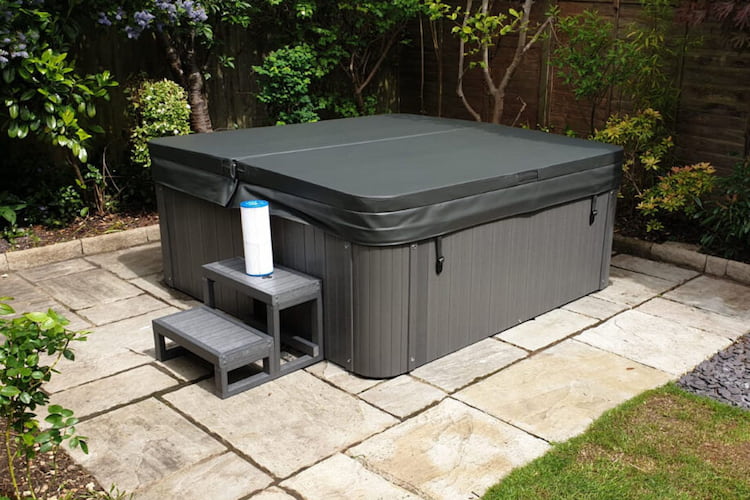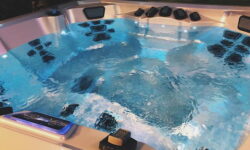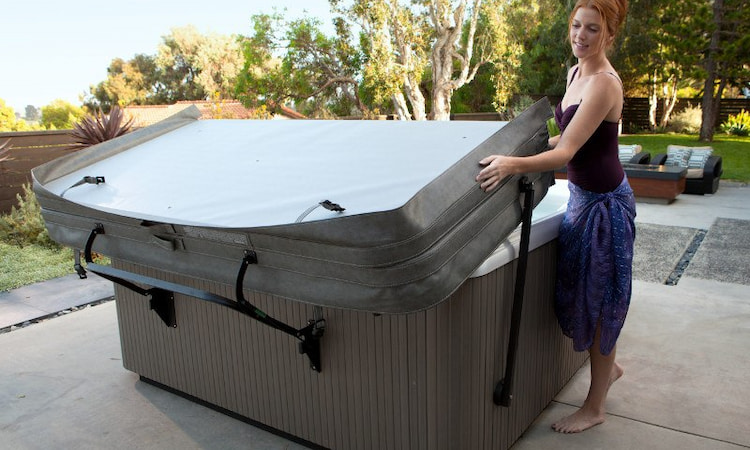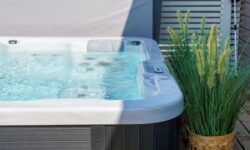You’ve noticed your hot tub’s water level is dropping faster than usual. Don’t panic! It’s likely due to normal evaporation or a minor leak. It’s important you understand the causes and effects of water loss in your hot tub.
Your hot tub could be losing water due to a leak in the shell, plumbing, or equipment. Cracks or loose fittings can allow water to leak out gradually. Another explanation could be evaporation, especially if you’re running the hot tub at high temperatures or live in a dry climate. If the water loss is significant or rapid, it’s more likely to be a leak than evaporation.
Let’s dive into how to identify potential issues, why maintaining water balance matters, and how a good cover can help. Remember, proper maintenance can save you a lot of hassle in the long run.

Quick Navigation
Understanding the Normal Water Evaporation in Hot Tubs
You’re first tasked with understanding what’s considered normal evaporation in hot tubs. It’s a common occurrence, caused by a combination of high temperature, wind exposure, and humidity levels. On average, you should expect a hot tub to lose about 1-3 inches of water per week due to evaporation alone.
Remember, this is an estimate and may vary depending on your local climate and how often you use the tub. In dry, hot conditions, evaporation can occur more quickly. Similarly, if you’re frequently using the hot tub, the increased movement can accelerate evaporation.
You must monitor the water loss closely. Consistently refill your hot tub to a marked level and note any significant drops over a week. If the water loss exceeds the 1-3 inches range, it might indicate a problem such as a leak.
Now, don’t panic if you’re seeing water loss. It doesn’t necessarily mean there’s a big issue. Sometimes, a simple adjustment like covering the hot tub when not in use can significantly reduce evaporation. Knowing what’s normal helps you identify when something’s off. So, keep an eye on your hot tub, and enjoy your soak worry-free.
Identifying Leaks in Your Hot Tub
Spotting the three common signs of a leak in your hot tub can save you a lot of trouble down the line.
These signs include a noticeable drop in water level, water stains around the tub, and soggy spots in the surrounding area. If you’re noticing any of these signs, it’s time to investigate further for possible leaks.
Let’s break down the process into a simple guide:
| Step | Description |
|---|---|
| 1. Observe | Look for visible signs like water stains or puddles around the tub. |
| 2. Check the Tub | Verify the water level. Is it dropping faster than usual? |
| 3. Inspect the Ground | Are there soggy or damp spots near the tub? |
| 4. Listen | Hear any unusual dripping or running water sounds when the tub is off. |
| 5. Professional Inspection | If you can’t locate the leak, consider calling a professional. |
Effects of Incorrect Hot Tub Water Balance
Maintaining the right balance in your hot tub’s water is crucial because an imbalance can lead to a myriad of problems, affecting the overall performance and longevity of your tub.
When the water’s balance is off, it could cause corrosion, impacting the tub’s shell, heater, and other internal components. This might not only result in inefficiency but also may need you to replace parts prematurely.
If your water is too acidic, it can irritate your skin and eyes. On the other hand, overly alkaline water might leave a residue on the tub, dulling its finish and blocking the filters. It can also lead to cloudy water, making your hot tub uninviting.
Preventing these issues is simpler than you’d think. Testing the water regularly using pH test strips will help maintain the right balance. If the water is too acidic, you can add a pH increase, and if it’s too alkaline, add a pH decrease.
Also, make sure to keep an eye on the total alkalinity and calcium hardness levels. Remember, a well-maintained hot tub not only lasts longer but also provides a more enjoyable soaking experience.
The Role of Your Hot Tub Cover in Water Loss

Almost all hot tub owners overlook the crucial role their tub cover plays in preventing significant water loss. It’s not just a lid for your tub; it serves a greater purpose. Here’s how:
- Insulation: Your cover acts as an insulator, trapping heat and reducing evaporation, which is the primary cause of water loss. Without a cover, your hot tub is exposed to cooler air, increasing evaporation and water loss.
- Protection: It shields your tub from debris and rainwater. Without it, excess rainwater will overflow your tub, leading to water loss.
- Safety: It prevents accidental water spillage. Kids and pets can inadvertently cause water to splash out of the tub. A cover keeps the water where it’s supposed to be.
- Preservation: It extends the life of your tub’s components. Keeping water in prevents the tub’s water level from dropping too low and potentially damaging the pump and heater.
Maintenance Tips to Prevent Hot Tub Water Loss
You’ll find that a few regular maintenance practices can significantly reduce your hot tub’s water loss. Firstly, check your hot tub for leaks frequently. Even a small leak can lead to substantial water loss over time. Look for wet spots around the tub and underneath the equipment. If you spot any, you’ll need to fix the leak immediately.
Next, monitor your water level. If it’s dropping faster than expected, it could be due to excessive splashing or evaporation. To minimize splashing, don’t overfill your tub, and be mindful of your movements inside it. As for evaporation, using a good quality cover when the tub is not in use should help.
Ensure that your hot tub’s water chemistry is balanced. Unbalanced water can cause damage to the tub’s components, leading to leaks. Regular testing and adjusting of your water’s pH, alkalinity, and sanitizer levels are crucial.
Lastly, carry out regular inspections of your hot tub’s equipment. This includes the pump, heater, and filter system. Damaged equipment can cause water loss, so replace any faulty parts promptly. Remember, prevention is always better than cure when it comes to maintaining your hot tub.
Frequently Asked Questions
You’re likely overfilling it or not securing the cover properly. Improperly balanced chemicals can also cause evaporation. Cracks or leaks in the tub or plumbing might be another issue. Remember to maintain it regularly.
Fluctuating weather can significantly affect your hot tub’s water level. In hot weather, evaporation increases, causing water loss. In contrast, cold weather may lead to contraction, reducing the water’s volume. Regular checks can mitigate these effects.
It’s not typically about specific brands being prone to water loss. Rather, you might notice more evaporation with larger tubs or ones with powerful jets. Regular maintenance can help prevent any unnecessary water loss.
Absolutely, water loss can impact your energy bills. If you’re constantly refilling your hot tub, it’s working harder to heat up, which increases energy use. Fixing leaks might help lower your bills.
Yes, frequency of use can impact water loss. More use often leads to more splash-out and evaporation. You’re also likely to top off the water more frequently, which can seem like higher water loss.
Conclusion
Understanding your hot tub’s normal water evaporation, identifying potential leaks, and maintaining a correct water balance is key to managing water loss. Your hot tub cover also plays a major role in conserving water.
Regular maintenance checks can help prevent unnecessary water loss. Remember, a little knowledge and proactive care can keep your hot tub running smoothly and efficiently, saving you time, money, and water in the long run.



![Is Yellow Hot Tub Water Safe? [& Treatment Options] is yellow water in hot tub safe](https://hottubtales.com/wp-content/uploads/2023/10/is-yellow-water-in-hot-tub-safe-250x150.jpg)
![How Many Gallons of Water in a Hot Tub? [Different Sized Hot Tubs] how many gallons of water in a hot tub](https://hottubtales.com/wp-content/uploads/2023/10/how-many-gallons-of-water-in-a-hot-tub.jpg)

